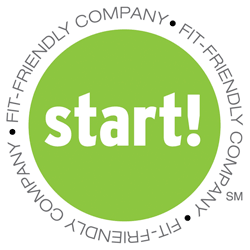
What is a typical work day like for you? A quick breakfast on the go, lots of coffee, fast-food lunch at your desk and then a birthday celebration for a co-worker with cake and ice cream? Sitting in front of a computer for eight hours, attending back-to-back meetings without a break, working late and racing against deadlines are all obstacles workers face that keep them from leading a physically active and healthy lifestyle. America’s corporate culture doesn’t always allow time for activities that benefit health and help employees de-stress. Many workplaces recognize this typical routine for American workers, and they are starting to do something about it. The American Heart Association applauds these companies and has created the Fit-Friendly Company program to award organizations that are providing a wellness culture for their employees by providing support and implementing healthy cultural changes in the workplace.
Heart disease is the number one killer of Americans, and several factors increase a person’s risk. Many of these risk factors are preventable—lack of physical activity, poor eating habits, high cholesterol, high blood pressure, high blood sugar, obesity and smoking. An estimated 25 percent of company healthcare costs are related to the risk factors listed above. The implementation of workplace wellness programs benefits both the employee and the company. These programs have been proven to increase productivity, reduce absenteeism and lower turnover rates, in addition to lowering healthcare costs.
Components of a Successful Workplace Wellness Program
The American Heart Association recommends implementing a comprehensive program aimed at improving employees’ cardiovascular and general health that includes the following components:
- tobacco cessation and prevention
- regular physical activity
- stress management/reduction
- early detection/screening
- nutrition education and promotion
- weight management
- disease management
- CVD education that includes cardiopulmonary resuscitation and automated external defibrillator training
- changes in the work environment that encourage healthy behaviors and promote occupational safety and health.
The American Heart Association recognizes Fit-Friendly Companies on levels based on the above criteria, awarding the company with one or a combination of the following statuses: Gold, Platinum, Workplace Innovation and Community Innovation.
Tips for Implementation
It is extremely important to have buy-in from the company’s management team to implement a successful workplace wellness program. The best way to do this is to appoint a wellness program coordinator who can send information to employees and set up healthy activities.
All workplace wellness programs should adopt a mission statement to lead employees to a succinct goal. Programs should also provide absolute confidentiality for employees, so they will feel confident about participating, and not that their job performance is directly related to the program.
Physical Activity. You don’t have to construct a gym in your office to encourage employees to exercise. Organizations can start walking programs, work out discounts with nearby gyms or offer reimbursement for purchasing exercise equipment. Organizations can also offer “physical activity comp time” to incentivize employees to work out.
Nutrition. Workplaces can make strides in offering foods that are healthier for employees, such as implementing a policy in the cafeteria that requires a minimum of one healthy option, replacing vending machine items with healthier foods and providing employees with healthy eating information through the website or email newsletters.
Education. Historically, wellness programs have included education and screening programs in an effort to increase individual workers’ awareness of risk factors and suggest strategies to modify health behaviors. Providing education from a trusted source, offering preventative screenings for employees and other educational components provide employees with the knowledge they need to improve their health.
Successful workplace wellness programs also offer Employee Assistance Programs (EAP) to provide counseling during difficult times, life coaching and other tools that help balance home and work life.
The Benefits and Challenges
Investing in workplace wellness programs can produce a great return on investment. Moving to a lower risk status can save up to $53 per employee, and that savings can recur each year the employee remains in the low-risk tier. Observational studies have also shown direct links to a reduction in absenteeism among employees when they reduce just one risk factor of cardiovascular disease. The reasoning is these employees who have chronic illnesses do not have to leave work for as many doctor visits and do not stay home sick as often.
The most successful workplace wellness programs have an on-site coordinator to run the program. Many small businesses do not have the manpower for this type of work, and the cost benefits from healthcare savings are much lower. Businesses that have a large number of employees that work on the road or from home should also consider how to integrate those workers into a program for their benefit.
For more information on workplace wellness programs, check out a complete study led by the American Heart Association at startwalkingnow.org/documents/WorksiteWellness9-09_000.pdf. iBi

